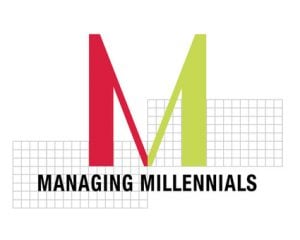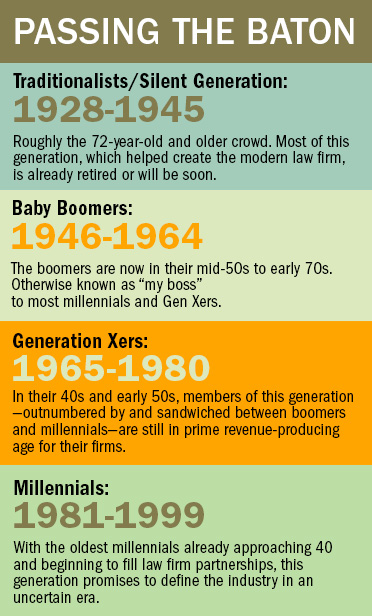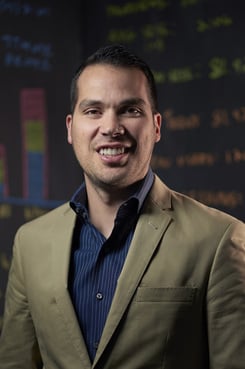Millennials Won't Destroy Your Law Firm. Can They Save It?
After years of complacency about their business model and the pipeline for talent, there's a reason law firms are so worried about managing the millennial generation.
October 23, 2017 at 05:05 PM
15 minute read
 Rawpixel.com/Shutterstock.com
Rawpixel.com/Shutterstock.com This article is the first in a series exploring how law firms and others in the legal industry are adapting to manage their millennial workers, from recruitment and real estate to training and technology and beyond.
For law firms wringing their hands about how to manage the millennial generation—or asking why they should adapt to this crop of young lawyers in the first place—here's the bad news: If you're still clinging to traditional models for training associates and running the partnership, you've already fallen behind.
The millennials are here, they're climbing the ranks, and they've already begun to transform the industry.
But there's good news, too. A decade after the Great Recession highlighted the industry's vulnerability, many firms recognize the need for new strategies. And for those that get this generation right, the changes they embrace may be key to success in a new era for legal services.
 Of course, the arrival of the millennials—born between the early 1980s and late 1990s—doesn't mark the first turning of the generational tide for most firms. “Is being different really any different than it was before? No,” said Justin Kay, chair of the firmwide hiring committee at Drinker, Biddle & Reath.
Of course, the arrival of the millennials—born between the early 1980s and late 1990s—doesn't mark the first turning of the generational tide for most firms. “Is being different really any different than it was before? No,” said Justin Kay, chair of the firmwide hiring committee at Drinker, Biddle & Reath.
But there is a difference, and it's not just traits like millennials' networking savvy, or their much-hyped need for recognition.
The difference is the timing.
Millennials, with all their generational quirks, are working their way up in the legal industry at the same time that many law firms face critical decisions about how to stay relevant in the greater economy—including how to compete for talent with the rising tech sector and legal industry disrupters. At the same time, young lawyers' millennial cohort are increasingly running the companies that firms want to represent. It's no surprise firm leaders are paying attention.
Many are already taking action. Morgan Lewis & Bockius and other firms are implementing remote working programs for associates that would have once been unimaginable. Cozen O'Connor created a choose-your-own-technology program for all lawyers. A number of firms have moved, remodeled or completely overhauled their physical workplaces with millennials in mind, favoring common areas, for example, over large corner offices.
Beyond work-life balance perks and in-house baristas, firms are giving young lawyers the influence they crave. Orrick, Herrington & Sutcliffe is getting junior partners involved in strategic planning through a newly-created commission. Skadden Arps, Slate, Meagher & Flom is letting associates pitch business ideas through an innovation contest. And Fennemore Craig has even added a millennial partner to its management committee.
“We are selling our talent,” said Jodie Garfinkel, director of attorney development at Skadden. “And, therefore, we are always listening to what our talent needs, so we can attract the best and the brightest.”
FACING REALITY
Law firm leaders have followed two main approaches to dealing with millennial employees, said Jordan Furlong, a legal industry analyst at Law 21. The first way is simply making them fit into the traditional law firm model, like a square peg in a round hole. The results, he said: “spectacularly unsuccessful.”
The alternative, Furlong said, is accepting millennials for who they are and working with their tendencies and preferences, instead of against them.
 “What's becoming more apparent to me is that law firms need millennial lawyers a lot more than millennials need the law firms,” Furlong said. “They might not think they do, but every day, we get closer to an entire generation of rainmakers and relationship partners and corner-office heavyweights shifting into retirement.”
“What's becoming more apparent to me is that law firms need millennial lawyers a lot more than millennials need the law firms,” Furlong said. “They might not think they do, but every day, we get closer to an entire generation of rainmakers and relationship partners and corner-office heavyweights shifting into retirement.”
Marcie Borgal Shunk, founder of law firm consultancy the Tilt Institute, said firm leaders' continued fixation on the generation is to be expected as millennials continue to fill the associate ranks, and as they begin to infiltrate the partnership level.
“It's true of virtually every industry right now,” Borgal Shunk said. “It is compounded in the legal industry because of the nature of the partnership track and the structure of the law firm.”
With baby boomers (born 1946 to 1964) largely on the brink of retirement, law firms are about to experience a major leadership vacuum, which Gen Xers (born 1965 to early 1980s) alone will be unable to fill.
“The millennial generation and the baby boomer generation are both much larger than Generation X,” Borgal Shunk said. “The millennials ultimately will be the ones to spearhead the industry into its evolution. Whatever new law is going to look like, it's going to be the millennials leading it.”
The demographic mismatch is real. According to Pew Research Center, there were around 75 million millennials in 2015 and 75 million Baby Boomers, but there were only 66 million Gen Xers.
Consultant Susan Saltonstall Duncan, founder of RainMaking Oasis, said she is already providing leadership training to some millennial lawyers who have risen into the partnership ranks and into junior leadership roles at their firms. Borgal Shunk said firms often ask her how they should approach training millennials for their future in heading up the firm. And multiple firm leaders said they provide training for partners, through internal and external resources, on how to bridge the generational gap.
“There's a lot of media coverage around 'they want to work at home in sweatpants.' That's such an oversimplification,” said Siobhan Handley, chief talent officer at Orrick Herrington & Sutcliffe. “They are the key to the future.”
THE POWER OF OPTIONS
Generation X, like many lawyers before them, came up in a strict, hierarchical, traditional law firm environment, said James Goodnow, partner and executive committee member at Fennemore Craig. And until recently, young lawyers had to “adapt or get out” of the legal industry, he said. But career alternatives changed that.
“Millennials as a group just aren't willing to do that anymore,” said Goodnow, who, still in his mid-30s, is a millennial himself. “There are too many options and too many places to go.”
Those options include in-house lawyering—in the fast-rising tech sector and elsewhere. But they also include positions with alternative legal service providers, virtual law firms, and legal jobs in other professional services businesses.
While the millennial generation is large, fewer of its ranks are going to law school, and even fewer are enticed by the traditional law firm lifestyle, said Handley, of Orrick.
“There's just much more competition, a much smaller talent pool, and then that group when they're coming in, they're not staying,” she said. “Partnership is not the Holy Grail it once was.”
Scott Connolly, director of professional development at Drinker Biddle, said he has seen that change first-hand while teaching classes at University of Pennsylvania Law School.
“Twenty years ago when I started with the firm… a lot of us talked about the path to partnership,” he said. “I don't see that now. I see much more of people thinking much broader about their careers.”
 James Goodnow of Fennemore Craig says millennials are less likely to think their only options are to “adapt or get out” of traditional legal industry jobs.
James Goodnow of Fennemore Craig says millennials are less likely to think their only options are to “adapt or get out” of traditional legal industry jobs.Firms have to think about how to stay relevant to young lawyers, said Orrick's chairman, Mitch Zuklie. “The war for talent…requires us to be more thoughtful about adapting our firms to the workplace they would find engaging,” he said.
Then there's the small matter of clients.
“If you were to look at the law firms that are out there and their client base, their client base is being more and more run by the millennials,” said Jonathan Littrell, managing partner at Los Angeles midsize firm Raines Feldman. Born in the early 1980s, Littrell toes the line between millennial and Generation X.
“If you're viewed … as an old-school law firm, I don't think the 30 year old who created the next Uber will be excited to use your firm,” Littrell said.
Borgal Shunk described the combination of greater options for young lawyers, new disruptive entrants to the legal industry and boomer-heavy partnerships as a kind of perfect storm.
“All of that is compounding,” she said. “It's exacerbating the generational difference.”
A CRITICAL MASS
Some of the changes associated with millennials started with the Gen Xers, said Mathieu Shapiro, managing partner of Philadelphia-based Obermayer, Rebmann, Maxwell & Hippel.
He recalled the expectations he faced early in his career—that associates would go out to network with potential clients every weeknight and come in Saturdays to make up for time lost on business development. To the leaders at that time, he said, working long hours, six days a week was part of the job. But that wasn't going to work for a generation of lawyers who were less likely than ever to have a stay-at-home spouse.
“In that sense, I was stubborn. I refused to conform,” Shapiro said. “When I was a kid, there were older partners who thought I didn't have the right attitude.”
Millennials seem to be taking bigger steps in the same direction. They're an optimistic generation, Shapiro said, who want “the best of everything.”
“We didn't have the critical mass,” said Furlong, a self-proclaimed Gen Xer. And Gen X was more practical-minded than the generations before or after.
“The boomers were absolutely visionaries, and, in their own way, so are the millennials,” Furlong said. “They love getting stuff done, and they love getting praised for it. … That's how they were raised.”
TURNING LAW FIRMS 'UPSIDE DOWN'
Just as the millennials are reaching a critical mass, their law firms are reaching a critical turning point for their business models.
“There's only so much growth we can have by continuing to grind out the hours,” Goodnow said. “We're at the beginning of large law firms being turned upside down. And frankly, that is a necessary thing.”
At the same time the first millennials were graduating from law school, the legal industry suffered a shake-up from which it has yet to fully recover.
“When the bottom fell out in 2008, business leaders realized they can't just continue to send the work to a law firm because they've done that for 50 years,” Goodnow said.
Post-2008, law firms continue to face challenges that started with the Great Recession. Their clients' increased attention to legal spending did not fade as economic indicators improved.
“Large law firms are no longer keeping pace with the economy. The question is: Why is that happening? At the core, it's because of years of complacency,” Goodnow said. “The legal industry doesn't take risk as a whole. Now firms are paying the price because of that.”
For example, fewer clients than law firms expected have demanded flat fees, contingent fees and other nontraditional billing arrangements, Goodnow said, so many law firms never moved to embrace them. But millennials won't see that as an obstacle dodged. They'll see it as a missed opportunity.
Billable hours and long-standing partner compensation schemes are the hallmarks of traditional law firm business models that “baby boomer partners are holding onto tightly to control,” Duncan said. But those practices have held law firms back from increasing efficiency and investing profits into updating their resources.
“I'm not suggesting that I think millennials won't want to continue to be in profitable businesses, but I think they'll be more able and willing to take a longer-term view of how they invest,” she said. “Maybe they reinvest 25 percent of the profits every year in major initiatives required to adapt to the marketplace.”
Additionally, Duncan said, many younger lawyers are less concerned about trade secrets and may be more willing to collaborate with others in the legal industry. Having come of age with the internet and social media networks, future firm leaders are more worried about missing out on the next revolutionary business practice.
“They're accumulating power now. They will pretty soon assert it,” Furlong said. “Once they've got the keys to the place, they're going to be making some pretty big renovations.”
One of the changes already underway is a shift in the amount of influence that younger lawyers are able to exert on management decisions.
“The challenge is, in a hierarchical world, lawyers across the country were trained not to speak unless spoken to,” Goodnow said. But millennials “were encouraged to speak up at the dinner table, were encouraged to speak up in school.”
And as teenagers and young adults, they were speaking up on a totally new platform—social media. Some boomers might roll their eyes at the young people attached to their phones, tweeting every thought that occurs to them. But Goodnow cautioned against dismissing the ideas of a generation.
“Leaders should care, if they want their law firms to exist. They need to start a dialogue,” he said. “You need to stop the millennial bashing, and you have to start conversations.”
A number of firms are doing just that.
Zuklie, who became Orrick's chairman and CEO in 2013, has since implemented town hall meetings with two-way feedback. The firm has also held training sessions focused on helping lawyers and staff from different generations relate to each other.
A year ago, Zuklie took a step toward getting young partners directly involved in the firm's strategy, forming the Higgins Commission. Named for a partner in New York who is leading the effort, the group of 20 junior partners, many of whom are millennials, were tasked with making recommendations for how the firm should operate in 2022.
Garfinkel, of Skadden Arps, said her firm has, for a number of years, examined how different generations, at times up to four, interact within the firm, and how management should respond to each generation's needs. The firm recently held an innovation contest, she said, in which about 170 associates entered their ideas for how the firm could improve itself.
Michael McTigue Jr., litigation chairman at Drinker Biddle, said his firm has also held management and feedback trainings, bringing in external resources that included material on millennials and intergenerational communication.
“We're always looking at … how to have a work environment that appeals to all of the generations within the firm” McTigue said. “We just have to ensure that this is one of the opportunities that will appeal to them in the long term.”
TAKING ON LEADERSHIP
Even if they have been immersed in a traditional law firm atmosphere so far, millennials are more likely to make changes once they're in charge, Duncan said. And those changes could ultimately help law firms survive disruption in the legal industry.
“If firms are really smart, they would accelerate some millennial leaders,” she said.
A few firms have done just that, like Raines Feldman and Fennemore Craig. Being a young law firm leader at Raines Feldman has given Littrell some opportunity for reinvention at his firm, he said. He lacks the multiple decades of law firm experience many managing partners have, but he also hasn't wedded himself to the traditions of the industry.
“There's a little bit more of a motivation to enact change,” he said. “It's not like I'm just going to be here another five years. I'm thinking 30 years out.”
Goodnow, of Fennemore Craig, said he is not the only millennial with a voice at his firm. Associates are included and take leadership in strategic committees, he said, and the firm's managing partner, Steve Good, has embraced some of their ideas.
“Many law firms don't like to single out what they call future stars,” Duncan said. But “if you don't give them the opportunities, you don't know until it's too late whether they're actually going to be great or not.”
And that time lost could mean losing out on a competitive edge, as millennial traits become the new mainstay in the legal industry.
“They're here,” Furlong said. “You can be baffled by them. You can resent them. You can fight them … or you can figure out, 'How can we work with them?'”
This content has been archived. It is available through our partners, LexisNexis® and Bloomberg Law.
To view this content, please continue to their sites.
Not a Lexis Subscriber?
Subscribe Now
Not a Bloomberg Law Subscriber?
Subscribe Now
NOT FOR REPRINT
© 2025 ALM Global, LLC, All Rights Reserved. Request academic re-use from www.copyright.com. All other uses, submit a request to [email protected]. For more information visit Asset & Logo Licensing.
You Might Like
View All
Adding 'Credibility' to the Pitch: The Cross-Selling Work After Mergers, Office Openings
5 minute read
Law Firms Are 'Struggling' With Partner Pay Segmentation, as Top Rainmakers Bring In More Revenue
5 minute read

Will a Market Dominated by Small- to Mid-Cap Deals Give Rise to a Dark Horse US Firm in China?
Trending Stories
- 1Gunderson Dettmer Opens Atlanta Office With 3 Partners From Morris Manning
- 2Decision of the Day: Court Holds Accident with Post Driver Was 'Bizarre Occurrence,' Dismisses Action Brought Under Labor Law §240
- 3Judge Recommends Disbarment for Attorney Who Plotted to Hack Judge's Email, Phone
- 4Two Wilkinson Stekloff Associates Among Victims of DC Plane Crash
- 5Two More Victims Alleged in New Sean Combs Sex Trafficking Indictment
Who Got The Work
J. Brugh Lower of Gibbons has entered an appearance for industrial equipment supplier Devco Corporation in a pending trademark infringement lawsuit. The suit, accusing the defendant of selling knock-off Graco products, was filed Dec. 18 in New Jersey District Court by Rivkin Radler on behalf of Graco Inc. and Graco Minnesota. The case, assigned to U.S. District Judge Zahid N. Quraishi, is 3:24-cv-11294, Graco Inc. et al v. Devco Corporation.
Who Got The Work
Rebecca Maller-Stein and Kent A. Yalowitz of Arnold & Porter Kaye Scholer have entered their appearances for Hanaco Venture Capital and its executives, Lior Prosor and David Frankel, in a pending securities lawsuit. The action, filed on Dec. 24 in New York Southern District Court by Zell, Aron & Co. on behalf of Goldeneye Advisors, accuses the defendants of negligently and fraudulently managing the plaintiff's $1 million investment. The case, assigned to U.S. District Judge Vernon S. Broderick, is 1:24-cv-09918, Goldeneye Advisors, LLC v. Hanaco Venture Capital, Ltd. et al.
Who Got The Work
Attorneys from A&O Shearman has stepped in as defense counsel for Toronto-Dominion Bank and other defendants in a pending securities class action. The suit, filed Dec. 11 in New York Southern District Court by Bleichmar Fonti & Auld, accuses the defendants of concealing the bank's 'pervasive' deficiencies in regards to its compliance with the Bank Secrecy Act and the quality of its anti-money laundering controls. The case, assigned to U.S. District Judge Arun Subramanian, is 1:24-cv-09445, Gonzalez v. The Toronto-Dominion Bank et al.
Who Got The Work
Crown Castle International, a Pennsylvania company providing shared communications infrastructure, has turned to Luke D. Wolf of Gordon Rees Scully Mansukhani to fend off a pending breach-of-contract lawsuit. The court action, filed Nov. 25 in Michigan Eastern District Court by Hooper Hathaway PC on behalf of The Town Residences LLC, accuses Crown Castle of failing to transfer approximately $30,000 in utility payments from T-Mobile in breach of a roof-top lease and assignment agreement. The case, assigned to U.S. District Judge Susan K. Declercq, is 2:24-cv-13131, The Town Residences LLC v. T-Mobile US, Inc. et al.
Who Got The Work
Wilfred P. Coronato and Daniel M. Schwartz of McCarter & English have stepped in as defense counsel to Electrolux Home Products Inc. in a pending product liability lawsuit. The court action, filed Nov. 26 in New York Eastern District Court by Poulos Lopiccolo PC and Nagel Rice LLP on behalf of David Stern, alleges that the defendant's refrigerators’ drawers and shelving repeatedly break and fall apart within months after purchase. The case, assigned to U.S. District Judge Joan M. Azrack, is 2:24-cv-08204, Stern v. Electrolux Home Products, Inc.
Featured Firms
Law Offices of Gary Martin Hays & Associates, P.C.
(470) 294-1674
Law Offices of Mark E. Salomone
(857) 444-6468
Smith & Hassler
(713) 739-1250










